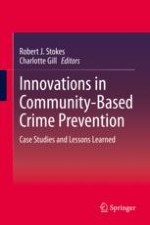2020 | OriginalPaper | Chapter
10. Applying the ACTION Framework to BCJI in Tucson, Arizona
Authors : Mary Ellen Brown, Katie Cotter Stalker
Published in: Innovations in Community-Based Crime Prevention
Publisher: Springer International Publishing
Activate our intelligent search to find suitable subject content or patents.
Select sections of text to find matching patents with Artificial Intelligence. powered by
Select sections of text to find additional relevant content using AI-assisted search. powered by
